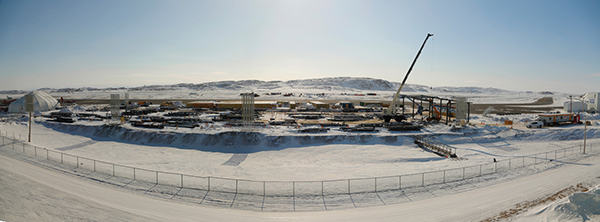New Iqaluit Airport on Schedule, Budget

By the end of this year, Iqaluit’s old yellow air terminal building will be history, replaced with a sleek red building eight times larger. The new facilities address overcrowding problems and will facilitate continuing future growth.
It’s part of the $298.5 million Iqaluit International Airport improvement project for a 10,000 sq. m. terminal building and also expanded aprons for planes to park, new lighting systems, an upgraded runway, and a new combined-services building (4,500 sq. m.) that will house the firefighting vehicles/support equipment and heavy runway and apron maintenance equipment like sweepers and snow ploughs.
From the start, the Government of Nunavut (GN) was set on a public private partnership (P3) for what is currently the most expensive capital project ever undertaken by the territorial government.
Arctic Infrastructure Partners (AIP) won the competition to design, construct, finance, operate and maintain the airport for another 30 years (2014-2047). AIP is a consortium formed by Bouygues Building Canada Inc. of Vancouver (a subsidiary of French multi-national construction firm Bouygues Construction), Sintra Inc. (a subsidiary of road construction firm ColasCanada), England’s investment banking firm InfraRed Capital Partners, and the Winnipeg Airport Authority.
According to a GN January 2014 report, Iqaluit International Airport Improvement Project, Nunavut is contributing $68.7 million, P3 Canada (a federal agency) is giving $72.8 million, and AIP will contribute the rest in the form of debt and equity. The GN is on the hook for additional operational funding and will pay AIP a total of $376.2 million before the consortium’s contract ends in 2047. The report states that the GN, “…is achieving value for taxpayers’ dollars of $99.8 million by procuring the project as a partnership,” as compared with a non-P3 approach.
Other benefits will include improved airport conveniences, enhanced security, more efficient and reliable operations, education and training opportunities for Inuit beneficiaries, and the ability to expand the airport in the future without significant work.
Stantec Architecture Ltd. and Stantec Consulting Ltd., hired to design the air terminal, aim for a LEED Silver-certified blueprint. A significant design feature is a 30-foot rotunda in a high traffic area.
“It is at the crossroads of the building,” says John Hawkins, director of the Iqaluit International Airport. “It is between the check-in area and arrivals and where passengers from the secure side will emerge. It’s on a raised platform and it is possible to set up a couple hundred chairs for scheduled public events where it fits into the airport schedule. The rotunda walls are reinforced to support art objects. It will be quite a dramatic place.”
The terminal will house two baggage carousels, two security lanes and five gates, including one to handle international flights. A large area in the terminal will be used for a behind-the-scenes baggage handling area, work that is now done outdoors and exposed to the elements.
While the terminal gets most of the public’s attention, at least half the construction work is on the airside where additional benefits are planned. The combined services building will allow easy access to repair the airport’s vehicles, from sweepers to snow ploughs, and cut down the time it takes to fill up fire trucks in case of an emergency from currently over half an hour to a few minutes.
All runway and apron surfaces are being re-paved, cracks fixed and insulated for a total of 400,000 sq. m. of pavement. The outdated lighting systems are being replaced with new lights and wiring. New taxiways include one leading out to a new commercial development area west of the terminal. These will allow for future construction of new hangars for helicopters and fixed wing aircraft.
Bouygues Building Canada and Sintra will take primary responsibility for the project’s design-build requirements and will use a number of subcontractors including local firms, Kudlik Construction Ltd. and Tower Arctic Ltd., to perform some of its design-build activities.
Construction began with a ground-breaking ceremony on July 10, 2014. Since then, the project has been on time and on budget, employing up to 160 workers on the terminal and airside improvements.
Upon completion of construction, Nunavut Airport Services Ltd, a subsidiary of WASCO, a subsidiary of the Winnipeg Airports Authority Inc., will take over the operations, maintenance, and life cycle planning of the new airport. Hawkins says the new airport is scheduled to commence operations Aug. 9, 2017.

